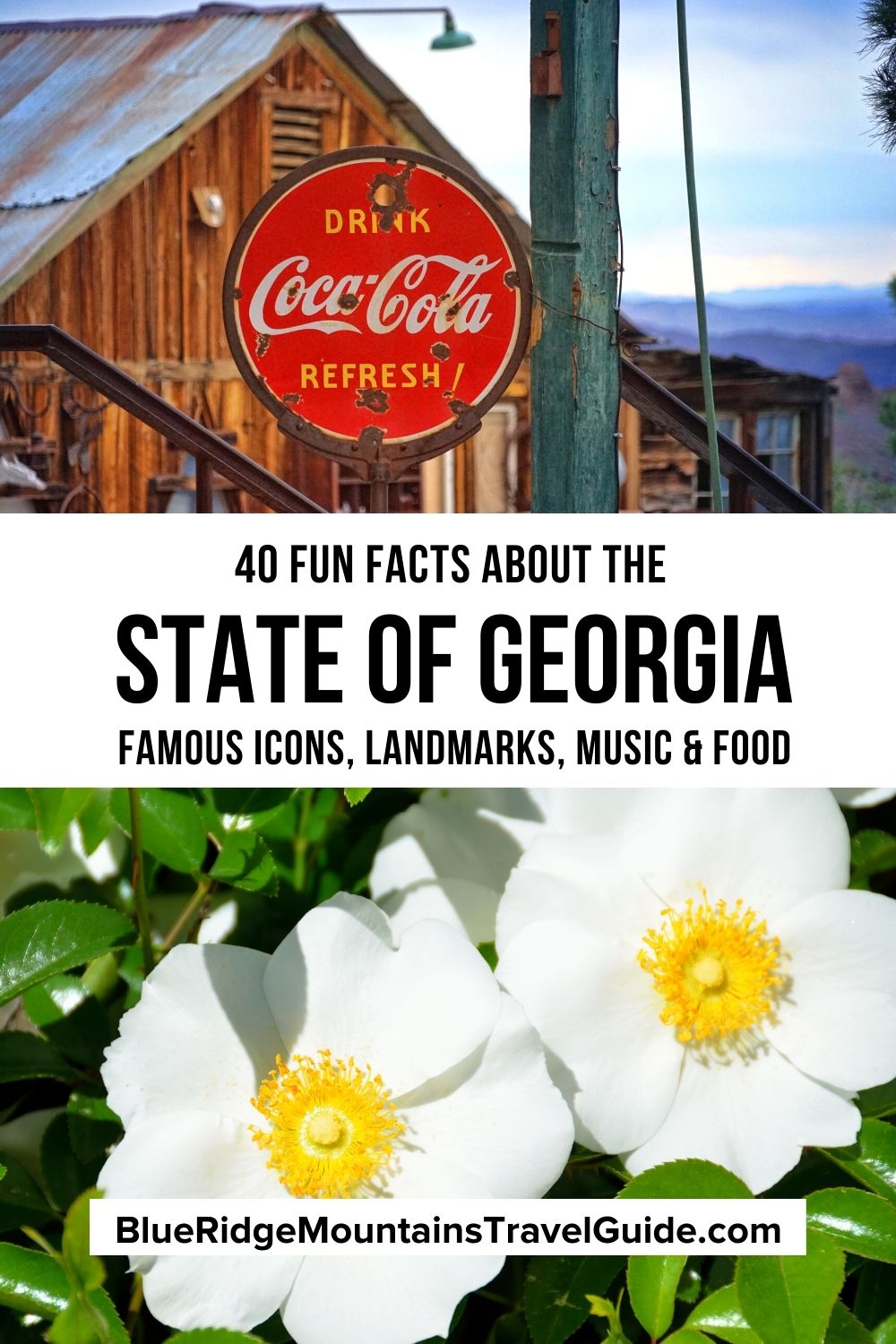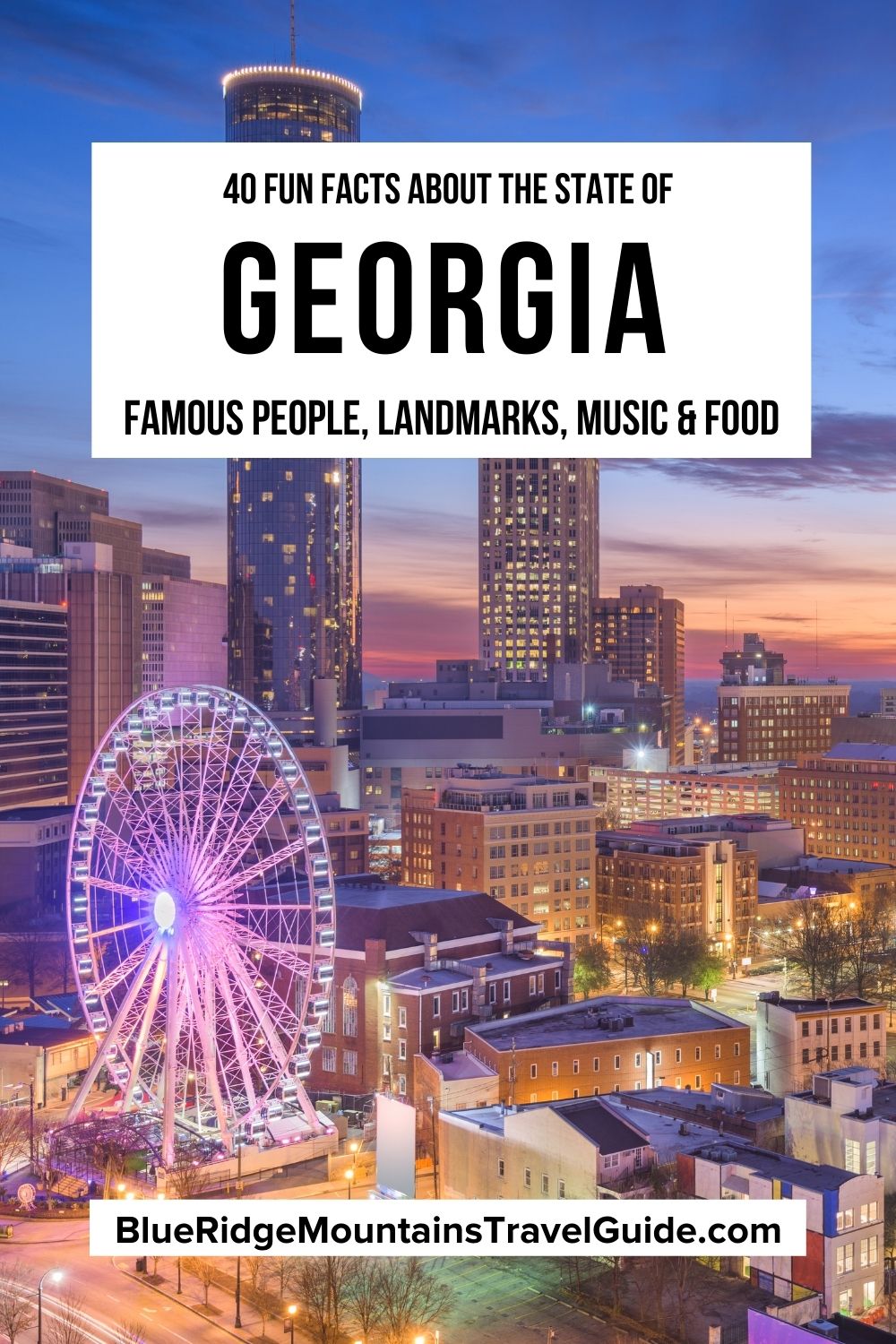[Updated 2/20/2023] You may have learned a little bit about the state of Georgia in school, or perhaps from your travels to the state.
Some of the more commonly known Georgia facts include that the state was one of the original 13 colonies, the birthplace of former US President Jimmy Carter, and that Hartsfield-Jackson International Airport is one of the busiest airports in the world.
But there are lots of other interesting tidbits of Georgia trivia you may not know.
For instance, did you know that the first American woman to graduate college with a bachelor’s degree did so at Wesleyan College in Macon GA?
Or that one of the biggest archaeological digs in U.S. history took place in 1933 at Macon’s Ocmulgee Indian Mounds, which is now a National Historical Park.?
The “Empire State of the South” not only offers southern charm and hospitality, but also a vibrant culture and an interesting history that could fill more than one textbook with colorful stories and rich Appalachian folklore.
If you’re interested in some Jeopardy-level knowledge about the state’s history and culture, read on to discover 45 fun facts about Georgia!
READ MORE: 101+ Things to Do in North Georgia
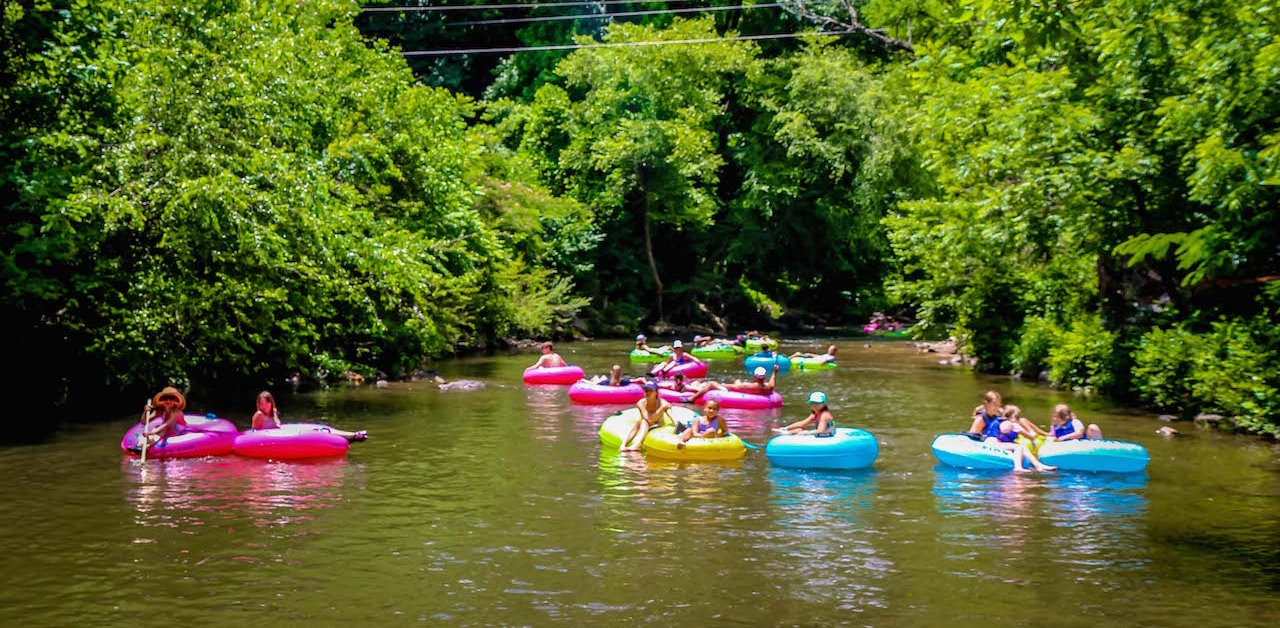
Fun Facts About Georgia State History & Culture Guide
- Early Georgia History Facts
- Famous Georgia Icons
- State of Georgia Landmarks
- Fun Facts About Georgia
- Interesting Facts About Georgia
- Georgia Music Facts
- Georgia Food Facts

Early Georgia History Facts
1. Named after King George II, the state of Georgia was established in 1732 as the last of the original 13 colonies. James Oglethorpe proposed using the area as a felon colony and refuge for London’s indebted prisoners, but it was ultimately founded to protect South Carolina from Spanish enemies in Florida.
2. The Cherokee people are one of the most prominent Native American tribes in Georgia. When the Cherokee Nation government began meeting in New Echota (in Calhoun GA) in 1825, it was officially named their capital. This was the site of the first Cherokee newspaper, the Cherokee Phoenix, as well as the first Cherokee Supreme Courthouse.
3. The Georgia gold rush was the first in America, beginning in 1828. Thousands of eager prospectors arrived to try gold mining in Georgia, which led to the Georgia Land Lotteries and the Trail of Tears.
4. One of the bloodiest skirmishes in American history, the Battle of Chickamauga took place in 1863. Today the battlefields are preserved by the Chickamauga & Chattanooga National Military Park. Encompassing 5,000+ acres in Georgia and Tennessee, it is the largest and oldest park commemorating the Civil War.
5. Georgia was the only colony that was founded and ruled by a Board of Trustees, which was based in London. This meant it had no governor or governing body in the colony itself and didn’t for the first two decades of its founding.
6. Georgia’s gold-covered capitol dome is located in Atlanta, the current capital, but the state has previously had five different capitals. The first was Savannah (1777-1785), then Augusta (1786-1789), Louisville (1789-1807), and Milledgeville (1807-1867). Atlanta finally became the Georgia state capital in 1868.
7. On January 19, 1861, Georgia was the fifth state to secede from the Union. Following the Civil War, Georgia was the last of the former Confederate states to be readmitted into the Union on July 15, 1870.
READ MORE: The 25 Best Day Trips from Atlanta GA
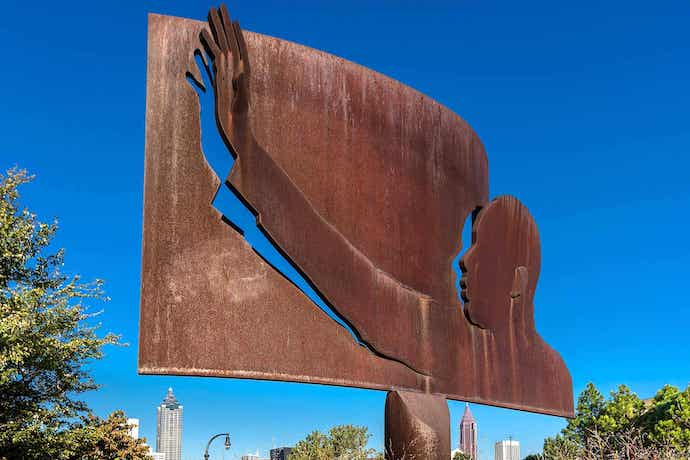
Famous Georgia Icons
8. During his time in Savannah in 1793, Eli Whitney invented the Cotton Gin, which went on to transform the American economy. After learning about cotton production and the painstaking process of cleaning cotton while in Georgia, he built a machine that could remove seeds quickly, effectively changing the game for the south’s cotton farmers.
9. Georgia was a major hub for the Civil Rights movement. In 1957, Martin Luther King Jr. co-founded the Southern Christian Leadership Conference in Atlanta, which played a significant role in organizing marches and protests. The SCLC is still active today and remains committed to fighting for equal rights and justice in America.
10. Jimmy Carter, who served as the 39th President of the United States, is the only president from Georgia to date. Born in the small town of Plains, he helped manage his family’s peanut farm before getting involved in politics. The former Senator and Governor is also a high-profile proponent for the Georgia-based Habitat For Humanity NGO.
11. Margaret Mitchell, the author of the Gone with the Wind, was born in Atlanta GA. Her time living in Georgia, and the stories she heard of those who lived in the state during the Civil War, inspired the famous story. The novel went on to win the National Book Award and Pulitzer Prize for fiction in 1937.
12. Although he was born in Alabama, John Lewis moved to Atlanta GA in 1967, where he was elected to the City Council in 1981 and served in the U.S. House of Representatives from 1987 until his death in 2017. As a Civil Rights activist, he was one of the original Freedom Riders, played a key role (alongside Martin Luther King Jr.) in the 1963 March on Washington, and co-led the famous “Bloody Sunday” march in Selma AL in 1965. A documentary about his influential life, John Lewis: Good Trouble, was released in 2020.
13. Originally born in Ohio, Ted Turner’s family moved to Savannah when he was 9. After graduating from Brown University, Turner used money from his father’s billboard business to launch Turner Broadcasting System, an early pioneer of cable TV. He also founded CNN (the first 24-hour cable news channel), TNT, and TCM; created Captain Planet (the first environmental superhero); and owned the Atlanta Braves and Atlanta Hawks. As a philanthropist, he gave $1 billion to create the United Nations Foundation and co-founded the Nuclear Threat Initiative.
READ MORE: The 15 Best Treehouse Rentals in the Georgia Mountains

State of Georgia Landmarks
14. Georgia is known for its impressive natural beauty, from majestic mountains and pristine forests to countless creeks, lakes, and rivers. The 7 Natural Wonders of Georgia include Amicalola Falls, the Okefenokee Swamp, Providence Canyon, Radium Springs, Stone Mountain, Tallulah Gorge, and Warm Springs.
15. Nestled in the Appalachian Mountains south of Blue Ridge GA, breathtaking Amicalola Falls is the tallest of the North Georgia waterfalls at 729 feet (with 7 cascades). Amicalola Falls State Park offers numerous different hiking trails, including the Springer Mountain approach trail and the popular Amicalola Loop Trail.
16. Located in Fannin County, Springer Mountain is the southern terminus of the Appalachian Trail, which stretches 2,190 miles north to Maine. There are some 76 miles of the Appalachian Trail in Georgia, including popular hikes from Woody Gap to Big Cedar Mountain and from 3 Forks to Springer Mountain.
17. Georgia’s Stone Mountain is the world’s largest piece of exposed granite, with a base circumference of 3.8 miles and a height of 1,500 feet. The controversial carving of Confederate Generals Jefferson Davis, Robert E. Lee, and Thomas “Stonewall” Jackson measures 90′ tall, 190′ wide, and 11′ deep, so it’s larger than Mount Rushmore!
18. The Ocmulgee Mounds National Historical Park in Macon is a prehistoric Native American site with evidence of 17,000 years of continuous human habitation. A 1933 archeological dig uncovered 2.5 million artifacts from various civilizations that lived on the Macon Plateau. Many of these artifacts remain on display at the national park’s museum.
19. The highest elevation point in Georgia is Brasstown Bald, which towers 4,784 feet high. There’s a viewing platform at the top that offers 360º views, which are truly jaw-dropping when the fall colors in North Georgia reach their peak. On a clear day, you can see four states: Georgia, North Carolina, South Carolina, and Tennessee.
20. Located on the border of Georgia and Tennessee, Lookout Mountain GA/TN was home to the Civil War battles of Chattanooga and Chickamauga in the early 1860s. The Blue Ridge mountain town is also home to many popular tourist attractions, such as the 145-foot Ruby Falls, the Incline Railway (which ascends the steepest part of the mountain), and the world-renowned Rock City.
READ MORE: The 40 Best North Georgia Cabins to Rent

Fun Facts About Georgia
21. Christmas in Georgia is a big to-do, with shimmering displays of Christmas Lights. There are several Christmas towns in Georgia where every inch of the main street is decorated, and fun Christmas events are scheduled throughout December. Christmas in Helen GA and Dahlonega’s Old Fashioned Christmas are not to be missed!
22. There are 71 streets in Atlanta that have some variant of “Peachtree” in their name. Many people assume this is due to Georgia’s reputation as “The Peach State.” But some historians believe the word is actually a reference to a Creek Indian settlement near Atlanta, “Standing Pitch Tree.”
23. The official State Bird of Georgia is the Brown Thrasher; the State Fish is the Largemouth Bass; and the State Tree is the Southern Live Oak. Georgia’s State Motto is “Wisdom, Justice, Moderation.”
24. According to the American Institute of Parapsychology, Savannah GA is the most haunted city in the USA. Many buildings there sit atop Native American burial grounds, and some roads cover cemeteries of enslaved Africans. Deadly battles, fires, and epidemics have also plagued the coastal city’s past.
25. In 1943, the State of Georgia became the first state to lower the legal voting age from 21 to 18. The campaign was famous for the slogan, “Old enough to fight, old enough to vote,” which referenced the fact that young adults who could not yet vote were fighting overseas in World War II.
26. Georgia has 159 counties, but only one named after a woman. Hart County was named for Revolutionary War heroine Nancy Hart. Folklore holds that the Cherokee called her “Wahatchee” (or “war woman”), and that Warwoman Dell in Clayton GA was named for her. Both Lake Hartwell and Hart State Park were also named for the anti-British fighter.
READ MORE: The 20 Best Lakes in the North Georgia Mountains

Interesting Facts About Georgia
27. Located in tiny Elberton, the controversial Georgia Guidestones offered tips on rebuilding a post-apocalyptic society. Listed in 8 languages, the 10 guidelines included instructions like “avoid petty laws and useless officials,” and “unite humanity with a living new language.” But nobody knows who funded the mysterious stones, or why. In July of 2022, the guidestones were mysteriously bombed, and the remains of the monument were dismantled later that day. As of February 2023, no suspects have been named in the crime.
28. The Georgia State Flower is the Cherokee Rose, which is linked to the signing of the Treaty of New Echota and the ensuing removal of Cherokee Indians. It was named for the tears shed during the brutal trek, and the chiefs prayed for a sign to give the women hope. They believed that wherever a tear dropped, a Cherokee Rose soon bloomed.
29. Known as “The Tree That Owns Itself,” there’s a white oak tree in Athens GA that, according to legend, has legal ownership of itself and all land within 8 feet of its base. The tree that stands today is actually the “Son of the Tree That Owns Itself.” The original fell in a storm in 1942, but locals planted a seedling from the original tree in the same spot.
30. Georgia is the birthplace of Juliette Gordon Low, founder of the Girl Scouts. Born in 1860 in Savannah, Low wanted to create a place where young girls could grow and learn leadership skills. Low’s home along Oglethorpe Avenue in Savannah was registered as a National Historic Landmark in 1965.
31. The Varsity in downtown Atlanta is the world’s largest drive-in restaurant. It covers two city blocks. with space for 800 diners inside and 600 cars in the lot. Open since 1928, the restaurant serves around 15,000 people a day. They start every guest’s dining experience with the famous greeting, “What’ll ya have… what’ll ya have?!”
READ MORE: The 20 Best Places to Live in the Georgia Mountains
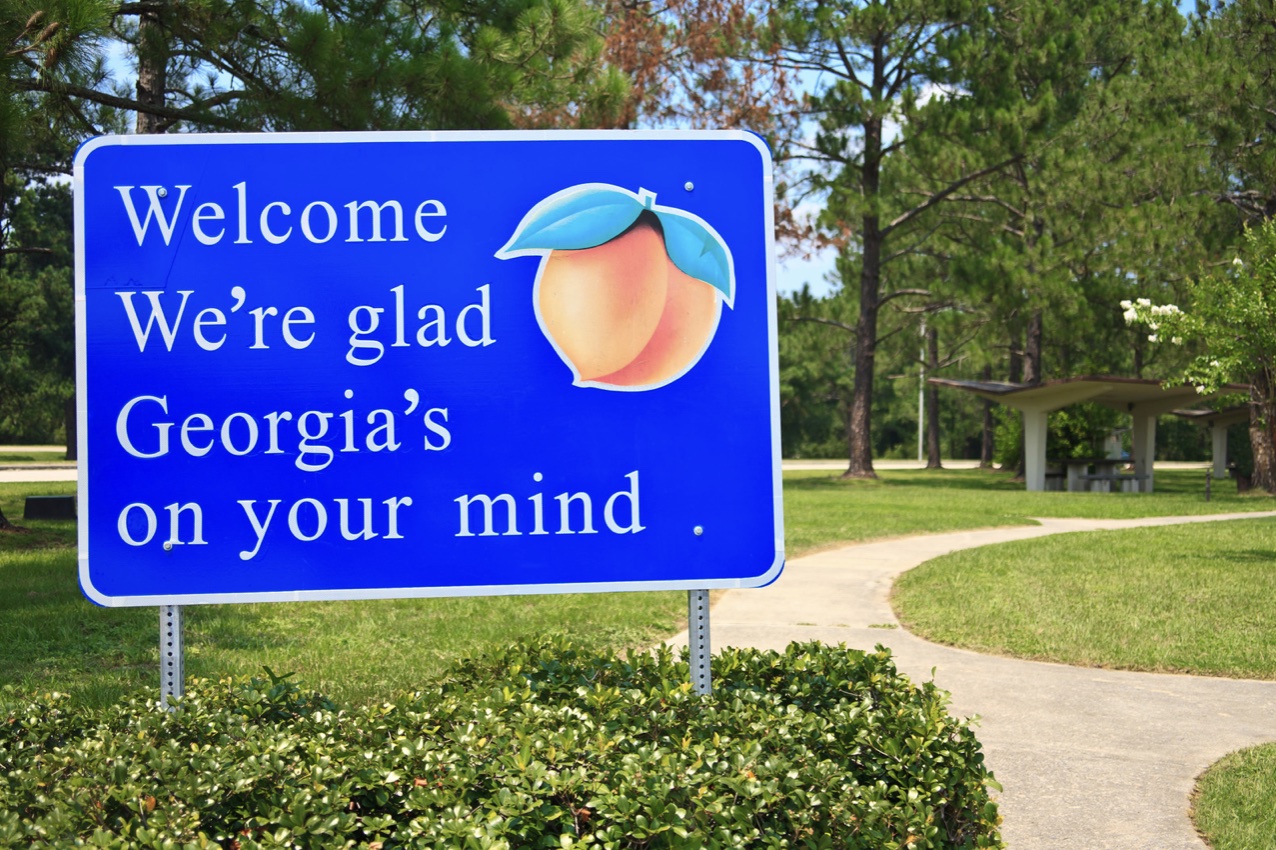
Georgia Music Facts
32. The ring shout is the oldest surviving African-American performance tradition in America. Originally practiced by enslaved Africans, it’s a combination of song, dance, and percussion, where worshipers move in a circle while stomping feet and clapping hands. The book Shout Because You’re Free documents GA’s McIntosh County Shouters.
33. Rome GA was the birthplace of Ma Rainey, who’s known as “the Mother of the Blues.” Widely considered among the first professional blues singers, Rainey was a turn-of-the-century vaudeville performer and later recorded with Louis Armstrong. She is honored every year at the Ma Rainey International Blues Festival in Columbus GA.
34. The beloved song “Georgia on My Mind” was written in 1930 by Hoagy Carmichael and Stuart Gorrell. But the tune is most commonly associated with Albany GA native Ray Charles, who recorded it for his 1960 album, “Genius Hits the Road.” In 1979, it was designated as Georgia’s official State Song.
35. Though James Brown was born in South Carolina, Georgia was where his music career took off. Long before he became the “Godfather of Soul,” he was singing in gospel quartets in Toccoa GA. After being front man for the Famous Flames (an R&B group), he eventually went solo, gained national recognition, and recorded 17 #1 hit singles.
36. After relocating from Jacksonville FL to Macon GA in 1969, the Allman Brothers Band‘s unique blend of rock, blues, jazz and country music influences garnered the attention of Phil Walden. After signing to Capricorn Records, they went on to put Southern Rock on the map, with hits like “Ramblin’ Man,” “Whipping Post,” and “Midnight Rider” influencing generations of jam bands. Today, the “Big House” in Macon where they wrote hits like “Blue Sky” has been turned into a museum where guests can take tours, see historic artifacts, and buy souvenirs.
37. Born Richard Wayne Penniman in Macon GA in 1932, Little Richard was the rock ‘n’ roll pioneer behind classics like “Tutti Frutti,” “Long Tall Sally,” and “Good Golly Miss Molly.” His deeply-rooted Christianity was often at odds with his sexuality: He wore flamboyant costumes and a full makeup when he performed, and came out as gay in 1995. One of the 10 original inductees into the Rock and Roll Hall of Fame in 1986, he influenced musical icons ranging from the Beatles and David Bowie to Elton John and Prince.
READ MORE: The Top 20 Things to Do in the Blue Ridge Mountains of Georgia

Georgia Food Facts
38. Agriculture in Georgia contributes $70 billion dollars to the annual economy. There are nearly 10 million acres of farmland in Georgia, with 40,000+ farms featuring vegetables, apple orchards, pumpkin patches, and Christmas Trees. The unique climate/geology of the Blue Ridge Mountains provides the perfect conditions for wineries in North Georgia.
39. North Georgia Wine grapes have actually been growing in the state for hundreds of years, but the wineries in the area didn’t gain much popularity until the late 1990s. The Wineries in Dahlonega GA are particularly popular. They are known for a combination of their delicious drinks, beautiful views, and southern hospitality.
40 Georgia is widely known as “the Peach State” due to its reputation for producing high-quality fruit, and peaches became the official State Fruit in 1995. In 1990, the Vidalia Onion (the sweetest onion in the world) was officially designated as Georgia’s State Vegetable, and in 1995 peanuts were selected as the official State Crop.
41. Georgia is known as the pecan capital of the U.S., producing more than any other state. The city of Albany alone boasts 600,000+ pecan trees and hosts the National Pecan Festival. The annual celebration includes a parade, pecan-cooking contest, and crowning of the National Pecan Queen, among other activities.
42. Coca-Cola was invented by Atlanta pharmacist John S. Pemberton in 1886.Originally created as a nerve tonic for exhaustion, the first glass was sold at Jacobs’ Pharmacy in downtown Atlanta. Today you can visit the World of Coca-Cola to explore the drink’s history and sample 100+ flavors from all around the world.
43. There are a number of excellent apple orchards in North GA where you can pick your own apples of differing varieties. The town of Ellijay GA is best known for the fruit leading it to be nicknamed “the Apple Capital of Georgia.”
44. Grits are a staple southern food that most kitchens in Georgia have probably cooked up at least once or twice. They are bits of ground corn or hominy that was first prepared centuries ago by Native Americans. The dish became so popular that in 2002, grits were designated as the official prepared food of Georgia.
25. Gainesville GA is known as the “Poultry Capital of the World” because of the numerous poultry farms in the city. Other towns that hold titles include Claxton GA (“Fruitcake Capital of the World”) and Cordele GA (“Watermelon Capital of the World”). –by Christina Maggitas, with additional reporting by Samantha Dickens

